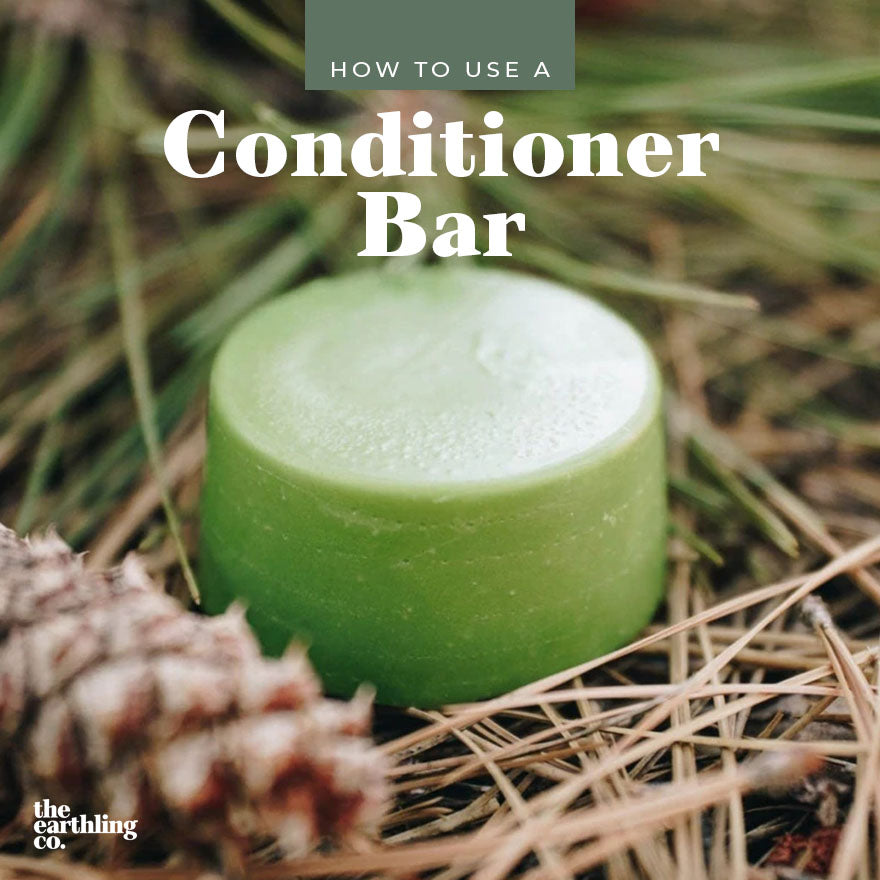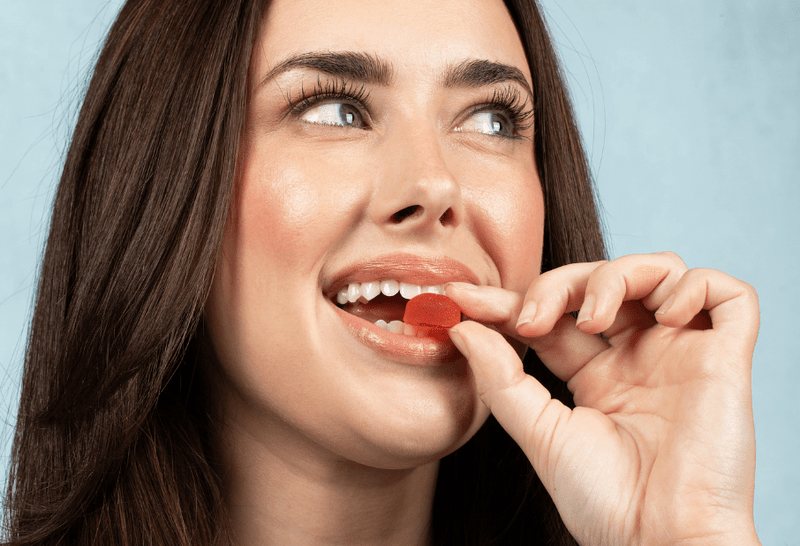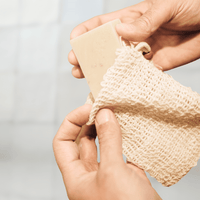
We all do things that dry out and damage our hair, whether we realize it or not. Blow drying, brushing, heat styling — they all take a heavy toll on our tresses. Even the simple act of washing our hair can strip the natural oils from our scalp, leaving hair vulnerable to split ends and breakage.
That’s where a moisturizing hair conditioner bar comes into play. Like its plastic-free sibling, the humble shampoo bar, conditioner bars typically boast all-natural ingredients that help reduce breakage and promote overall hair health.
On top of being good for your hair, conditioner bars are good for the environment. Scientists estimate that 8.3 million metric tons of virgin plastics have been produced since the 1950s — and this number will continue to increase as the world population grows even larger. Conditioner bars help reduce plastic waste because they typically come in biodegradable paper boxes or even package-free.
Another perk of conditioner bars? They make ideal travel buddies so you don’t need to stress about violating TSA liquid rules or suitcase spillage when you bring them on a plane.
Convinced yet? Read on to learn more about conditioner bars, including who should use one and how to use a conditioner bar the right way for your healthiest hair ever.
Shop Conditioner BarsWhat Is a Conditioner Bar?
A conditioner bar from The Earthling Co. is essentially a solid, highly concentrated version of your standard liquid conditioner — only way better. That’s because our conditioner bars are jam-packed with organic and plant-based ingredients like coconut oil and shea butter, which nourish hair while restoring moisture loss and reversing visible signs of damage. Additionally, our bars are made without fillers, parabens, phthalates, sulfates, silicones and other potentially harmful ingredients.
While product formulations vary from bar to bar, they all share one common trait: they’re entirely water-free. This is worth emphasizing because most of the liquid shampoos and conditioners you see on store shelves contain up to 70 percent water, which means you’re buying a watered-down product with fewer active ingredients and more preservatives to keep bacterial growth at bay.

By taking water out of our formulas, we’re able to pack more hair-strengthening ingredients into our conditioner bars. Thus, you’re getting more vitamins, minerals, proteins and other important nutrients seeping into your strands. The end result? Smooth, silky tresses that are strong, healthy and easier to style!
Which Hair Types Can Benefit From a Conditioner Bar?
The short answer: all of them. It doesn’t matter whether your hair is short, long, color-treated, pin-straight or afro-textured. Every hair type can benefit from the deeply hydrating effects of our hair conditioner bars.
That being said, some hair types may stand to benefit from conditioner bars more than others. For instance, if your hair is curly, frizzy, dry or damaged, a conditioner bar may be nothing short of a game-changer for you. Thanks to their high concentration of active ingredients, conditioner bars are like a turbo-boost of nutrients for your tresses!
Additionally, people with sensitive scalps and skin allergies may benefit from using The Earthling Co. conditioner bars. That’s because our conditioner bars are free from harsh chemicals like sulfates and artificial fragrances, which are known to irritate the skin and dry out hair.
Related: What Does Conditioner Do?
What Should I Look for on the Ingredients Label?
It depends on the specific needs of your hair. If you have thick, curly or dry hair, choose a nutrient-rich conditioner bar with moisturizing properties. For color-treated hair, it’s a good idea to find a conditioner bar that’s sulfate-free and color-safe. Dealing with fine hair or limp strands? Look for a silicone-free conditioner bar with coconut oil and sweet almond oil, which offer lightweight hydration.
Regardless of hair type, there are a few things that everyone should look for on the ingredients label of their hair conditioner bar. These include:
- Hair-boosting vitamins. If you want to have thicker, fuller and healthier-looking hair, choose a conditioner bar with plenty of nutritious vitamins. Specifically, look for panthenol, a form of vitamin B-5 which helps strengthen hair and retain moisture, and tocopherol, a form of vitamin E which supports a healthy scalp.
- Fatty alcohols. Not all alcohols are bad for your hair! Fatty alcohols such as glycerin and cetyl alcohol are considered “good alcohols” because they work to condition hair naturally. In contrast, short-chain alcohols such as isopropyl alcohol fall into the camp of “bad alcohols” due to their ability to dry out hair and roughen up the cuticle.
- Silicone-free. Silicones are notorious for building up on the scalp over time, making hair feel dry and frizzy and causing curls to go flat. If you want healthy, bouncy curls, stick to a silicone-free formula.
- Artificial preservatives. Parabens, phthalates and other synthetic preservatives often creep into the formulas of hair care products because they’re cheap and help extend the product’s shelf life. These synthetic chemicals are considered hormone disruptors due to their ability to mimic estrogen and disrupt the endocrine system in various ways. Thankfully, the solid nature of conditioner bars means that you’re less likely to see these harmful ingredients listed on the ingredients label. (Still, it’s not a bad idea to check!)
- Sulfate-free. If you spot the ingredients sodium lauryl sulfate (SLS) or sodium laureth sulfate (SLES) in your conditioner bar, put it back on the shelf. Often used as emulsifiers and thickeners in conditioner formulas, these harsh detergents are known for robbing the scalp of its natural oil and making hair feel dry and brittle.
- Plastic-free packaging and shipping. OK, so this one has nothing to do with hair health. But if you want to feel extra good about your new ’do, why not choose a conditioner bar that doesn’t come wrapped in unnecessary plastic? Here at The Earthling Co., we package and ship our shampoo and conditioner bars 100 percent plastic-free. We’re also offsetting the carbon emissions of your package and are proud to be Climate Neutral Certified!

How to Use a Conditioner Bar
Wondering how to use a conditioner bar? Don’t worry — it’s super easy! Follow the steps below to get healthy, moisturized strands, minus the plastic waste.
Step 1: Start with Clean, Wet Hair
Just like liquid conditioners, conditioner bars should be applied to clean, wet hair. That way, your scalp and hair will absorb the maximum amount of hair-strengthening nutrients.
On your next washday, hop in the shower and reach for your favorite shampoo bar from The Earthling Co. Then, follow these easy steps:
- Wet the shampoo bar before you apply it to your wet strands.
- Lather the product in your hair, focusing primarily on the scalp and roots of your hair.
- Thoroughly rinse out all of the remaining shampoo bar residue from your hair.
Prefer to co-wash? Ignore this step and move on to the next one!
Shop Shampoo BarsStep 2: Rub the Bar Between Your Hands or Apply Directly onto Hair
There are actually two different techniques you can use to apply a conditioner bar. The first method involves rubbing the bar between your hands for about 10 seconds. This will create a creamy lather, which you can then work through your strands, just like regular conditioner.
Another way to apply conditioner bars is to apply it directly to your hair. With this method, you’ll take the conditioner bar in one hand and sort of “paint” it onto your strands.
No matter which method you choose, it’s important to apply your conditioner bar from the mid-length of your hair to the ends, taking care to avoid the roots entirely. The glands that produce sebum (oil) are located right next to the roots of your hair, so applying a conditioner bar to your roots could weigh them down and make your scalp look greasy.
Then again, if a dry scalp is to blame for your brittle, straw-like locks, applying a conditioner bar to the roots could be a great way to give your hair and scalp the moisture it so desperately craves. Do what feels right for your scalp and your hair type!
Step 3: Allow the Product to Sit in Your Hair for 2-3 Minutes
A common mistake with conditioner bars — and conditioner in general, really — is washing the product out of the hair too quickly. Remember all those hair-strengthening nutrients we were talking about earlier? Well, you need to give them a chance to penetrate the hair strands so they can make your hair soft, shiny and healthy! To ensure that the ingredients have enough time to sink into the strands, leave the product on for two to three minutes before you rinse it out.

A Few More Helpful Tips and Tricks
- Wet the conditioner bar before you apply it to your hair. This will help the bar glide more easily onto your hair and produce a better lather.
- Speaking of lather, don’t be alarmed if your conditioner bar doesn’t produce any foamy-looking suds. Our conditioner bars don’t produce a lather because they’re free from sulfates — the aggressive detergents that strip the natural oils from the scalp and hair.
- Squeeze a little water out of your hair before you apply your conditioner bar. If your hair is dripping wet, the ingredients will simply run off the strands of your hair and go down the drain. You want your hair to be damp so that each strand can absorb the maximum amount of nutrients.
- If you have long hair, make sure you thoroughly coat the ends. Consider holding just the ends in the palm of your hand and painting the conditioner bar onto them.
- Store your conditioner bar (and your shampoo bar!) on a soap dish with good drainage. This will prevent your bars from becoming mushy while extending their lifespan. Additionally, keep your bars outside of the shower when you’re not using them.
- Run your fingers or a wide-tooth bamboo comb through your hair to ensure the conditioner is evenly distributed all the way to your ends.
Can I Use My Conditioner Bar as a Leave-In Conditioner?
Yes, absolutely! Using a conditioner bar as a leave-in conditioner is a great way to save money, downsize your product arsenal and give your strands an extra boost of nutrients.
Unlike the liquid conditioner you might find at a grocery store, our conditioner bars are silicone-free, which means they’re less likely to cause buildup that can weigh your hair down. For this reason, they’re a great leave-in treatment for those with curly hair in particular.
If you want to use our conditioner bars as a leave-in conditioner treatment, simply follow the steps listed above, except the part where you rinse out the product. Instead, leave a portion of the conditioner in your hair. If you have an extra thick or long mane, you may want to be a little more generous with how much conditioner you leave in your hair.
Another tip for using a conditioner bar as a leave-in treatment — start by leaving a small amount in your hair. Remember: If you accidentally rinse out too much of the product, you can always add more!
The Bottom Line
Making the switch to solid conditioner bars can be intimidating, but it doesn’t have to be! Just follow the steps above and you’ll be well on your way to achieving effortlessly lustrous locks — not to mention, one step closer to a plastic-free hair care routine!
Looking for a conditioner bar that ticks off all your boxes? Check out plastic-free conditioner bars from The Earthling Co., which are formulated with nourishing vitamins that revitalize dull, dry and damaged hair. Our moisturizing conditioner bars are great for all hair types — including color-treated hair!
Image Credits
ArtKio/Shutterstock.com
Feodora_21/Shutterstock.com
gravity_point/Shutterstock.com









